
I’ve been around dogs my whole life, all the way back to when I was a young child on a dairy farm in central Pennsylvania, to now, when our six kids are now adults. And, I still don’t quite understand how dogs came to be, why we are so lucky to have them as companions, and why we have become as attached to them as they are to us.
I know of course that dogs came from wolves, and that monks or farmers or someone like that bred them for various purposes, but it just doesn’t seem to be the whole story.
Like how does an Australian Shepherd know how to herd sheep? They are born with that ability! “Oh, it’s just instinct”, people say, as if that explains it, but really that tells us absolutely nothing at all. “Instinct” is just a word with no explanation what it is and how it works.
All animals have instincts, such as the packing instinct, for a dog or a wolf, or learning to stand up immediately, if you’re a deer, so as to avoid those packs of dogs and wolves.
Now I can understand how these behaviors evolved–deer that don’t stand up fast are easier prey with a very short lifespan, and a wolf that doesn’t hunt in a pack will starve. However, what’s with the herding? Or fetching a duck that a hunter shot? How was that sort of thing bred into a breed of dogs’ genes?
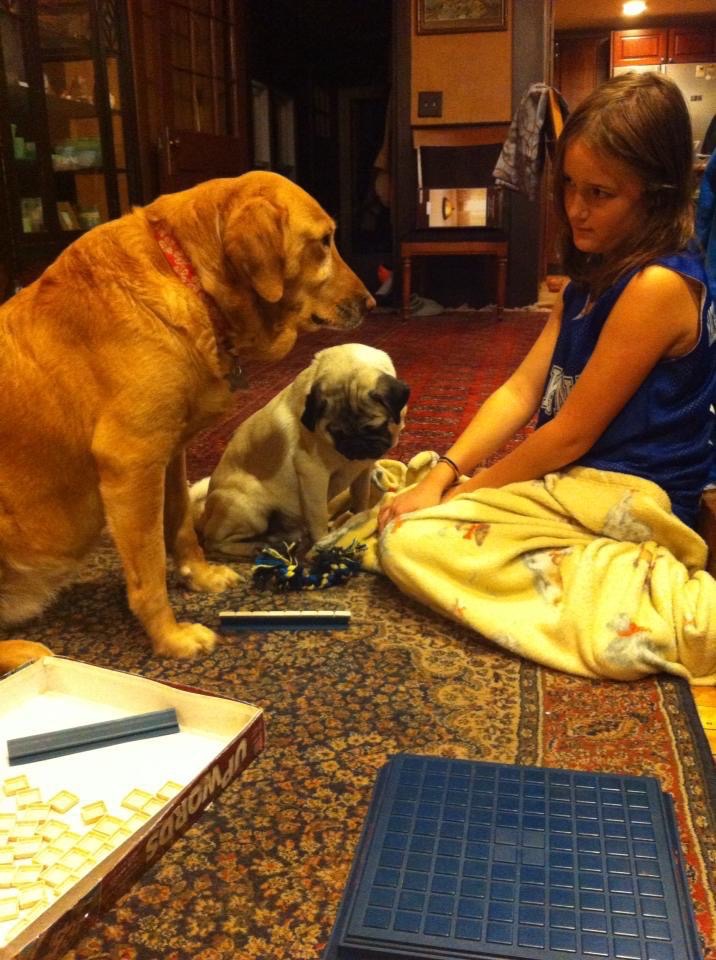
Dogs have instincts too, but their inherent traits make them so much more human than expected. Sometimes I feel a bit like a knucklehead for being so attached to them. They’re just dogs.
When we sit out on the deck in the evening, hanging out with them, and I think, “what great friends” and then I look at them and they sure don’t look like people…..covered in fur, no arms but four legs, a tail and big nose and teeth, claws but no opposable thumbs, and a very limited vocabulary consisting of barking, whining, and growling.
They certainly shake hands differently when greeting each other. But we’ve got the exact same emotions. That’s what’s truly surprising and wonderful.
Of course how “good” a dog is has quite a bit to do with how they are treated and raised. Again, exactly like people. The farm dogs, living on that Pennsylvania dairy farm, were only “semi domesticated”, but that applied to the people too.
Pennsylvania is said to be “Philadelphia and Pittsburgh wrapped around Appalachia”, and that’s pretty accurate. Life is sometimes hard, in the foothills of the Appalachians. Farming is an around the clock job, and animals, particularly cows, chickens, and pigs, were well taken care of but not treated particularly nicely.
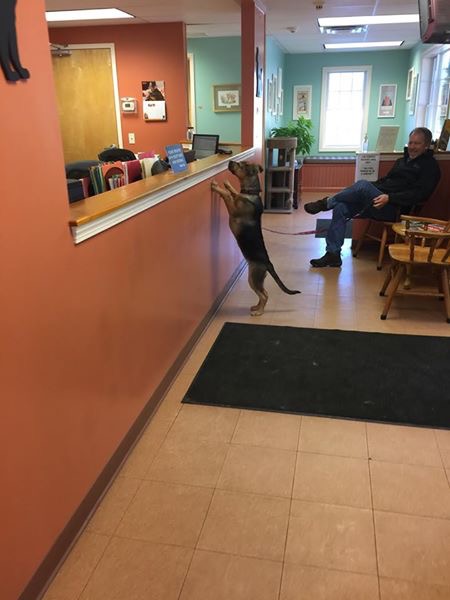
Cows are huge, dumb and stubborn and like to kick, so they got whacked more than a few times to get them out of or into the barn, for milking, and pigs of course were simply raised for their meat. Chickens? Those were pretty much on their own, and given the wildlife around a farm, protecting the chickens was a good part of a farm dog’s job.
The farm dogs I grew up with basically ran wild, sleeping in the barn at night and pretty much doing nothing during the day except following the farmers around, sleeping, or getting in fights with other dogs.
Rarely was a dog “fixed” (accounting for the fights), and even more rarely did they see a vet. A dog license? Not likely. If a dog got injured, it was on its own. Dogs were just one level above barn cats, and their job was to be alert to and keep out intruders, human and otherwise.
Interestingly, “otherwise” back then included roaming packs of basically wild dogs, which resulted in some spectacular dog fights. You don’t see this type of thing anymore, but I distinctly remember a collie mix farm dog getting in a ferocious fight with a stray wild dog on the stone foundation of a railroad bridge about twenty feet above the water.
The fight ended with the wild dog falling off the rocks and into the water, and washing away downstream. The stray dog was probably fine but wet, and was never seen again.
So these dogs, which weren’t exactly raised in what we’d consider a kind, loving environment, behaved accordingly. Nevertheless they were fiercely loyal to their owners, did their jobs diligently, and importantly, adapted to the way their owners behaved towards them.
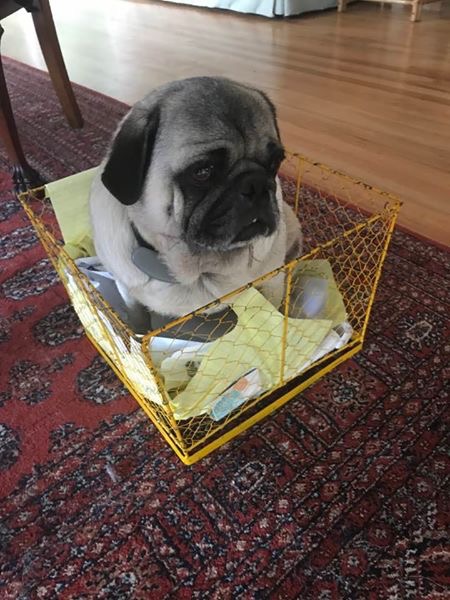
Dogs are certainly treated differently now. Just letting your dog roam the neighborhood is frowned on at best, as is not having your dog fixed, or making it sleep outside, or avoiding the vet.
In our house, seeing the vet is a common occurrence, typically resulting in a $200+ bill and an appointment for a followup visit to make sure the pet is still OK. With three dogs and a cat, the vets know us by name.
What has changed is not the dogs–they remain loyal and diligent in their duties, and they still adapt completely to their owners, taking on their characteristics. What has changed dramatically is how we interact with dogs.
It’s almost embarrassing how much I personally like our dogs. We have three, with wildly different personalities and skills–yet again, just like people. We have two shepherd mixes, Layla and Scout, and the infamous pug that graces Jen’s business cards and real estate signs. Each dog has a distinct personality, as well as different skills.
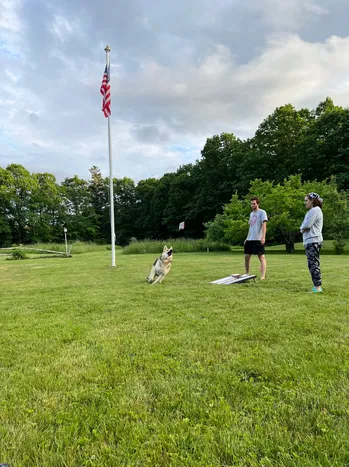
Pugsley (now there’s an original name for a pug), has one big (and only) skill–he sells houses. People recognize Jen as “the lady with the pug” on her signs. Other than that, at the advanced pug age of 12, he’s a bit short on other skills or endearing characteristics. For instance: Pugsley can get down the mudroom steps, but not back up, which he never takes into account when going down the stairs. Once he realizes he’s stuck, he starts howling at the top of his lungs until someone lets him out the front door to walk around the outside of the house, to the dog door.
Similarly, since he sleeps in a crate at night due to his unfortunate habit of marking his territory, he howls like a rooster upon waking up, a racket that continues until he either falls back asleep or more commonly, is let outside by someone who is sick of hearing him howl at 5:30 AM.
He’s also quite embarrassing when taken to the vet–he panics, tries to bite the vet (and even me once), and sometimes befouls the room, which is embarrassing by extension…..I feel like saying “whose dog is this?”
The funny thing though is that he’s a really sweet dog underneath, who loves to be petted and get attention, but pugs were bred so radically that he simply has too many physical shortcomings, which certainly weren’t his idea. Plus, we’re his third owner, and I don’t think his prior owners appreciated him like we do.
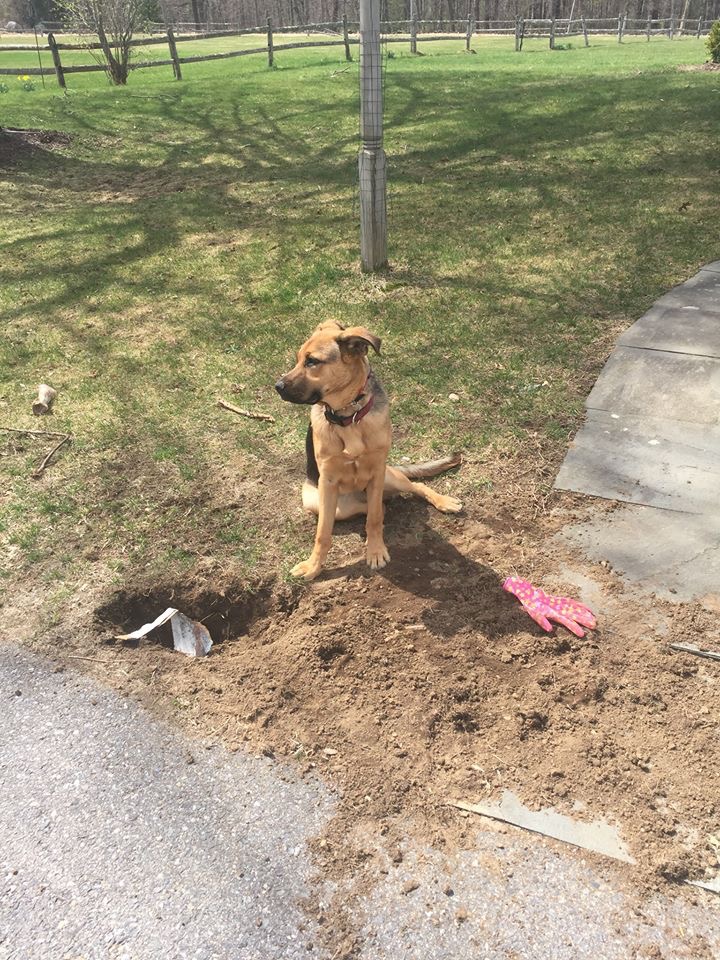
The other two dogs are both shepherd mixes, but very different dogs. Scout, the older of the two, is a German Shepherd/Red Bone Coon Hound mix. We got Scout directly from the accidental breeders (who apparently weren’t careful enough keeping male and female purebred dogs apart), so Scout has never known anything but living with us.
Layla, on the other, completely opposite other hand, spent time in a kill shelter down south, as well as with another family, before landing in Princeton with us.
Layla looks more like a Shepherd than Scout, except for her pointy nose, making us think perhaps she’s part collie. So they look similar, but that’s about it for similarities.
Scout is a genius, as far as dogs go, because she actually knows a few words. I had to find a porcupine in our yard that quilled Layla, so I asked Scout (who knows better than to get quilled, after her first time) where the porcupine was. I couldn’t believe it. She trotted right over and peered up at it, sitting on a limb of an apple tree.
Scout also knows the word “turkey”, which was useful when the turkeys were eating our seeded grass area. I’d just say “turkey” and out the door she’d fly to chase them away.
However, with a degree of smarts also comes a degree of disobedience. She knows that she is not allowed on couches, but sneaks up on them anyway at night. She also doesn’t show up right away when called, if she happens to be doing something else ‘dog important’, which can be irritating. Oddly, Scout was the last dog to learn how to use our dog door, probably because she was too smart to consider walking head first into a solid object, which would then swing open and let her out. Layla had no issue with it.

Layla is the opposite–she barges into all sorts of things, follows me everywhere, all the time; and does whatever is necessary to please us, including coming immediately when called.
What Layla isn’t, however, is particularly smart or brave. It’s as if she has no idea that she’s a great big dog (90 pounds)– she’s afraid of a lot of things, probably thanks to the kill shelter.
And we speculate that she was taken from her mother too soon too, which is why she clings to us constantly. She’s a tough dog to pet, because the instant you pet her, she slumps over and falls down….hence the name, Layla.
Layla’s also mesmerized by our cat Cindy, as well as afraid of her. Cindy makes this high pitched warning hum that sounds like a jet engine crossed with a ghost, resulting in Layla simply staring at her, stupefied by the experience while keeping her distance.
So why are we so attached to dogs? I just wrote about our dogs like a parent talking about their kids, only minus the criticism we impart to our kids. Our dogs even sleep in our room (but not on the bed) at night.
This is a far cry from my parents’ generation, when dogs typically weren’t even allowed in the house.
Dogs in particular, but really all animals (since nature is efficient), share a lot of human emotions. You can immediately tell if a dog is overjoyed (jumping around), happy (wagging its tail), disappointed (downcast eyes), feelings hurt (head hanging down, whimpering), loyal (the dog won’t leave your side), mad (shows its teeth and growls), scared (hangs out by your leg and maybe growls), loving (gazes at you raptly), and about anything else you can think of. The one great skill humans have, that a dog does not, is the ability to fake emotions or lie. You know exactly what a dog is thinking when it’s with you.
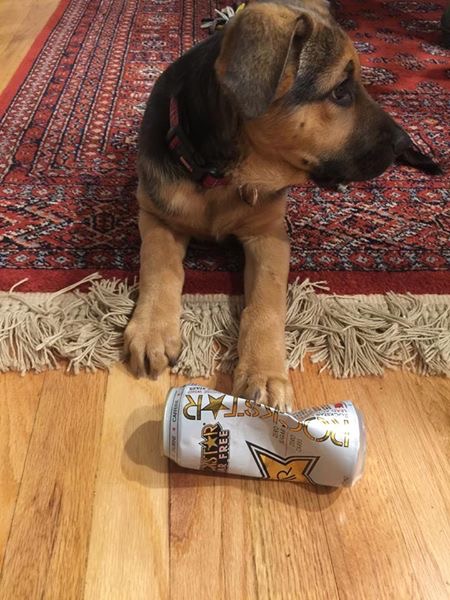
Also, some breeds of dog have eyes that are eerily human, although some don’t. Scout, the coon hound mix, has brown eyes that would fit fine on a beautiful woman. Layla, on the other hand, has yellowish eyes that would look appropriate on a wolf about to attack you. Poor Pugsley’s eyes look as bad as his eyesight actually is. He’s cute, but pugs were bred so their eyes bulge out, and consequently they have a lot of eye issues. Pugsley is no exception.
So what is it about dogs that makes us so crazy about them? It’s the human emotions of course, but just as important are the human traits they don’t have, which makes them a lot easier to deal with than kids or other adults.
Dogs are virtually incapable of faking it or lying. Sure Scout might sneak up on the couch at night, where she’s not supposed to sleep, but all you have to do is point at the couch and sternly say, “were you on the couch?”, and she might as well be holding up a sign that says “I did it”, as she slinks off.
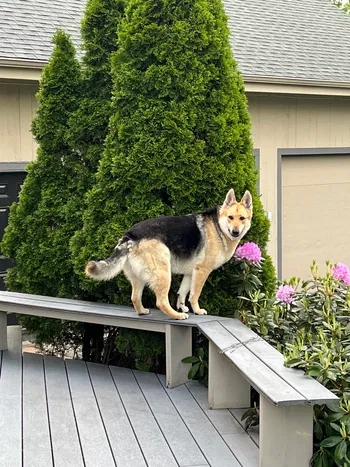
And a dog certainly isn’t going to compete with you for anything. Not only are they pack animals that know their place, but they are the least ambitious creatures ever. “Nothing to do? No one to bark at? I guess I’ll just sleep for eleven hours straight.”
Dogs also don’t hold grudges. Even if a person is mean to a dog, or actually hits a dog, they’ll react to that by flinching sometimes when that person is around, but amazingly, they’ll still be loyal.
Dogs do react differently to people that behave like that, but except for extreme cases of physical abuse, they are very forgiving. If you go off in a car, and they want to go along, but you’re dressed up for some reason and don’t want to get covered in fur on the trip, the dog won’t be mad at you when you arrive back. Instead, it’s the same every time…..Hopping around, tail wagging, etc. If they could talk they’d say, “thank god you’re home safe”, over and over again.
I used to commute to NYC during the week, and when I got home I’d be eager to see Jen and the kids, but I’d actually forget I had dogs. I’d walk in, and they’d be beside themselves with joy that I’d returned. They certainly weren’t thinking, “where have you been! It’s about time you got home.”
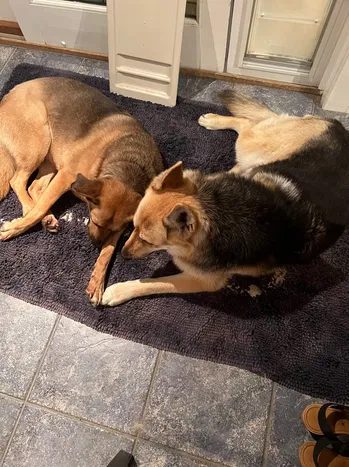
Supposedly, dogs will even give up their life to protect their owners. Now I’m not too sure about this one, with the dogs we’ve got, but it’s possible, excluding the pug of course.
Although we have German Shepherd mixes, they don’t strike me as the “I’ll die for my master” type. But you never know, and hopefully I’ll never find out. And you’re way better off with a dog that just looks scary rather than with one that will actually bite someone. A dog’s job is really to warn about intruders, but in this litigious age you don’t want them attacking the Fedex driver, for instance.
It’s easy to understand why humans and dogs have been coexisting so well for so long. We have a mutually beneficial relationship. We get love and unconditional loyalty, as well as warnings of danger from our dogs, and they in turn, get fed, taken care of, and let’s face it, love back.



